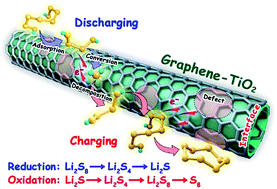Accelerated Li–S chemistry at a cooperative interface built in situ†
Abstract
The performances of lithium–sulfur (Li–S) batteries have been markedly impaired by intricate multi-electron sulfur chemistry involving reversible conversion of polysulfides (LiPSs) to Li2S upon discharge and back to S8 upon charge. Herein, graphene in situ coated TiO2 nanotubes are realized via a direct chemical vapor deposition (CVD) technique, leading to the design of a graphene–TiO2 (G–TiO2) promotor for Li–S chemistry. With the aid of detailed experimental and theoretical characterization, we reveal that the direct CVD-derived G–TiO2 realizes not only the coupling of Li+-ion diffusion and electron transfer but also efficient regulation of LiPSs, thereby producing a synergistic catalyzing effect on both LiPS conversion and Li2S decomposition. As a result, S/graphene–TiO2 (S/G–TiO2) presents a remarkable rate capability and an ultralow capacity decay rate of 0.052% over 1000 cycles at 2.0C. Even at a high sulfur loading of 9.4 mg cm−2, such a cathode still delivers a superior areal capacity of 8.7 mA h cm−2. This work would motivate the deep-seated revisiting of the sulfur reaction mechanism and offer a rational strategy to construct high-energy and long-life Li–S batteries.



 Please wait while we load your content...
Please wait while we load your content...